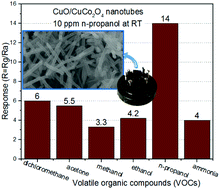P–p heterojunction CuO/CuCo2O4 nanotubes synthesized via electrospinning technology for detecting n-propanol gas at room temperature
Abstract
Semiconductor materials based on composite metal oxide nanomaterials have attracted enormous attention recently due to their unique chemical and electrical properties. P–p heterojunction CuO/CuCo2O4 nanotubes were synthesized by simple single-capillary electrospinning technology followed by a heat treatment process to achieve the tubular structure. Nanotubes with diameters in the range of 60–70 nm with a large specific surface area of as-prepared materials have been demonstrated by scanning electron microscopy (SEM), transmission electron microscopy (TEM), and N2 absorption–desorption isothermal analysis (Brunauer–Emmett–Teller, BET) of composite CuO/CuCo2O4 nanotubes. The composition and crystal structure of CuO/CuCo2O4 nanotubes were confirmed by X-ray diffraction, energy-dispersive X-ray spectrometry (EDX) analyses, and X-ray photoelectron spectroscopy (XPS). Room temperature gas sensing performance of CuO/CuCo2O4 nanotubes toward n-propanol gas was investigated, where a response of 14 with rapid response (6.3 s)–recovery (4.1 s) times have been measured for 10 ppm n-propanol at room temperature. The stability, selectivity and sensing mechanism of p–p heterostructure CuO/CuCo2O4 nanotubes were investigated and discussed as well.



 Please wait while we load your content...
Please wait while we load your content...